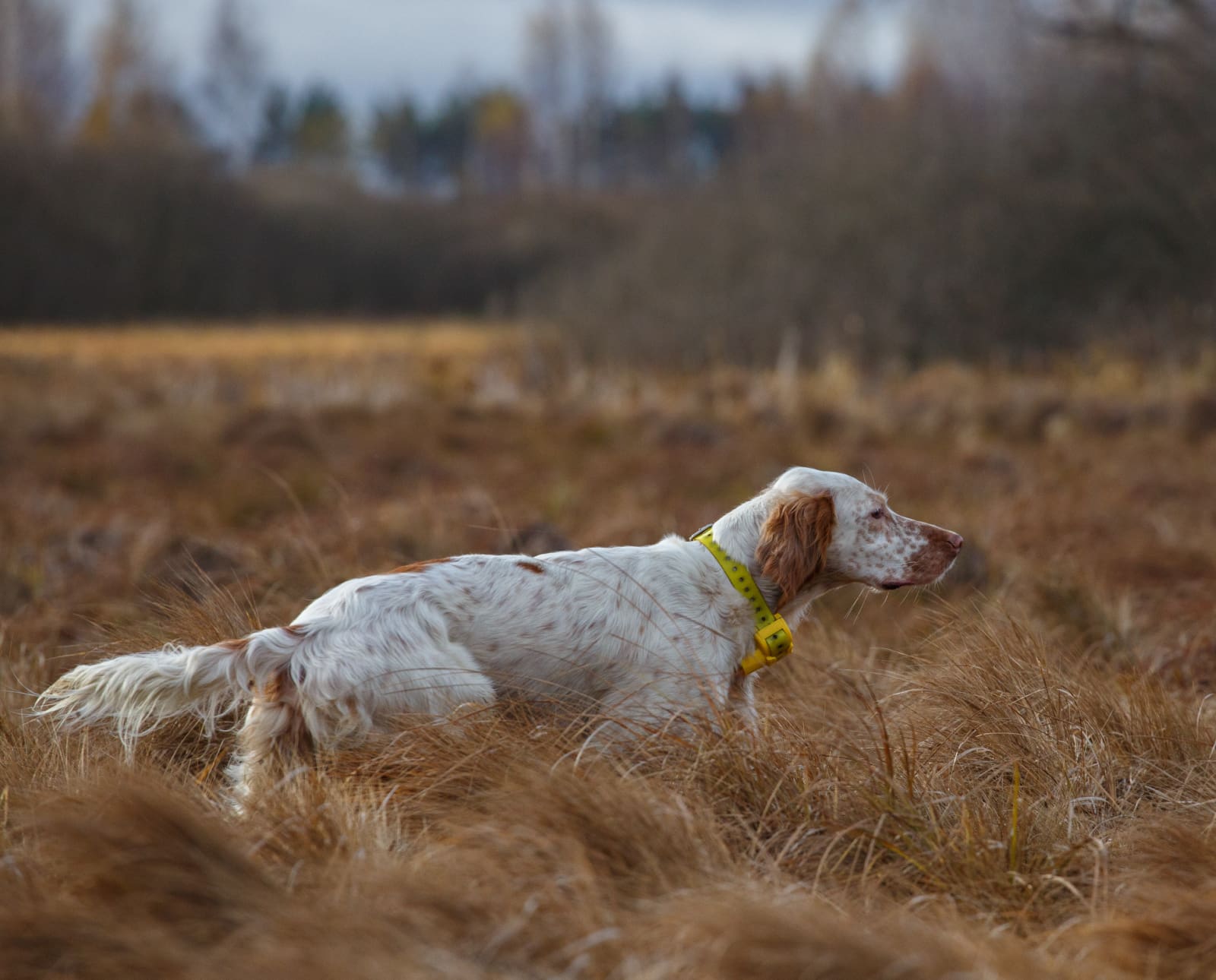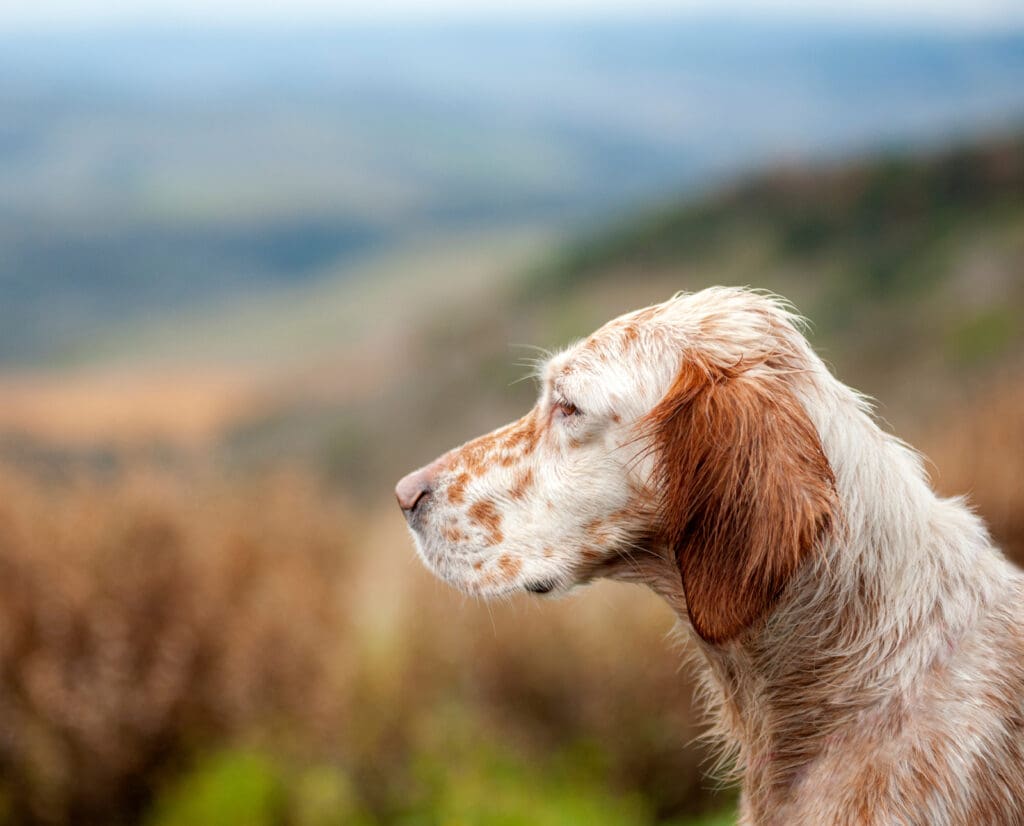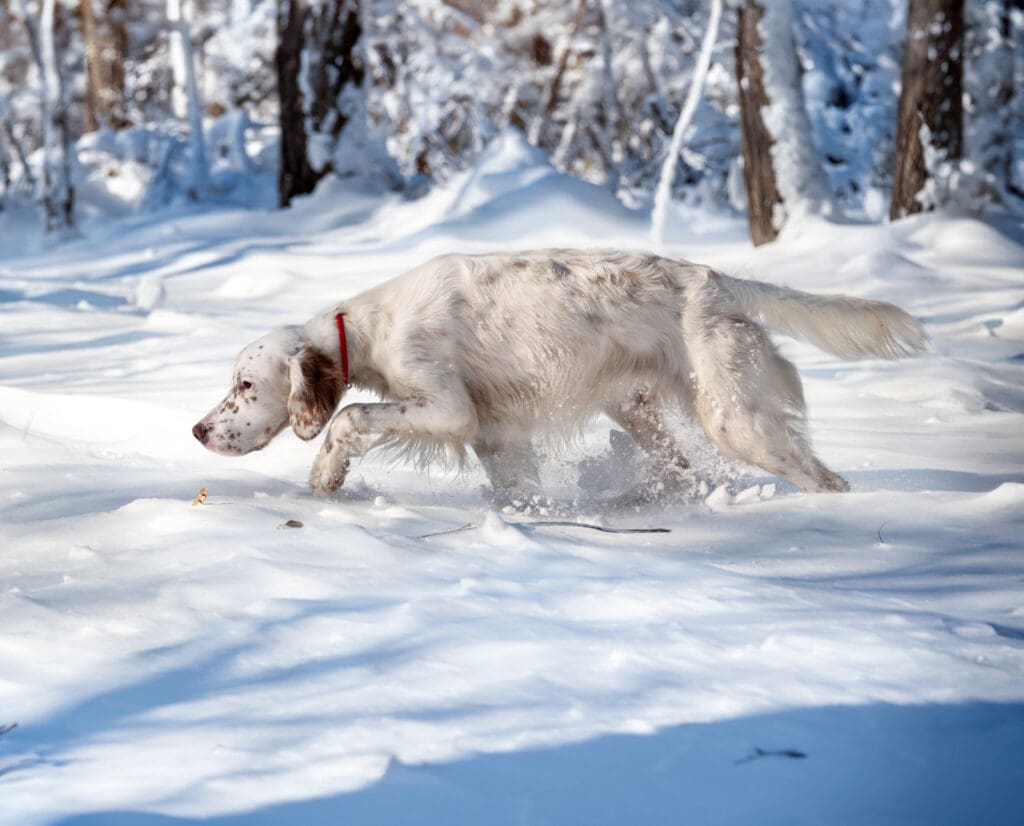Home » Hunting Dogs » Llewellin Setter: Characteristics, Training, and Hunting Ability
Llewellin Setter: Characteristics, Training, and Hunting Ability

Gabby Zaldumbide is Project Upland's Editor in Chief. Gabby was…
The beautiful Llewellin Setter is quick to learn, highly trainable, and makes a loving companion in the woods and at home.
Setters are incredible dogs that offer a wide diversity of type, hunting tendencies, and coat colors. Although some may be harder or softer than others, and some pups may be slightly more hesitant to retrieve, there are two constants that remain regardless of breed or strain: their beauty and amazing companionship in the field and at home.
Listen to more articles on Apple | Google | Spotify | Audible
Llewellin Setters have a bit of a complicated history. Richard Purcell-Llewellin, a figure in the iconic book The Setter, is the father of the Llewellin Setter, dating back to their early years in England. Regardless of their past, there is a strong modern appreciation for Llewellin Setters today. Crystal Powell, the secretary for the National Llewellin Gun Dog Club (NLGDC) and co-owner of Sinking Fork Llewellins, and Paint River Setters’ Kyle Warren have offered in-depth insights about this strain of English Setters and generously shared their knowledge of this impressive, eye-catching dog.
Llewellin Setter Characteristics and Form
| Characteristics | Details |
| Name | Llewellin Setter |
| Size | Females: 20-24” and 28-50 lbsMales: 20-24” and 35-60 lbs |
| Tail | Full-length |
| Coat | Very long to short and tight. Feathering on ears, legs, and tail. |
| Coat Color | Wide variety, including blue, orange, chestnut and tri-color belton, black and white and tan, chestnut and white, black and white, orange and white, and chestnut and white and tan. Tan ticking in tri-color combinations only occurs on the legs and face. |
| Health Issues | Very uncommon. Hypoglycemia, hypothyroidism, urinary infection via protein processing issues, and, depending on the line, skin allergies |
| Character | Wide variety of personalities. Intelligent and cooperative with high drive, but a very soft temperament. |
| Population | Unknown; the vast majority are in the United States |
| Range | Varies depending on the habitat. Close-working in thick woods, far-ranging in open county. |
| Pace | Varies depending on the habitat. Slower in dense cover, faster in open county. |
| Good Choice For | Grouse, American woodcock, quail |
Warren captured the essence of Llewellins perfectly when he said, “There is so much diversity, it’s really hard to put a label on them.” You can listen to him talk even more about Llewellins in this Birdshot Podcast episode.
Much like English Setters, Llewellin Setters come in a variety of sizes, coat colors, and personality types. This most likely results from a lack of a breed standard. The Field Dog Stud Book (FDSB) recognizes them as a strain of English Setters, but currently, no breed or performance standards exist.
Because of the vast array of personalities and traits found in Llewellins, folks who are interested in having a pup join their family should research breeders to get a feel for what line might work best for them. Regardless of size or color differences, this dog is known for being very human-centric and easy to train, thanks to its incredible instincts.
Typical colorations for Llewellins include blue, orange, chestnut and tri-color belton, black and white and tan, chestnut and white, black and white, orange and white, and chestnut and white and tan. If there’s tan ticking in a tri-color combination, it only occurs on the legs and face. These coat colors occur in both long and short coats. “When it comes to the most common coat lengths,” said Warren, “they range from furball-long like European lines and Laveracks to super tight and short.” Regardless of overall coat length, they have feathering behind their ears, down their legs, and along their tail.
As the trend in variability continues, Llewellins also vary regarding weight and height. Males and females range between 20 and 24 inches at the shoulder. Their weight varies even more greatly. “My females typically weigh between 28 and 38 pounds, and my males are generally 36 to 45 pounds,” said Warren. “However, depending on the breeder, females can get to 50 pounds, and males can weigh up to 60. Plenty of Llewellins exist at these heavier weights.”

Llewellin Setter Training and Hunting Ability
Llewellin Setters are known for being intelligent, quick to learn, and born with a strong innate ability to find birds. As a result, Warren affectionately deems them a “100-hour dog, not a 300-hour dog.” He also believes they’re the easiest dog a professional trainer will ever train if the dog’s pedigree is of good quality. Powell agrees, saying, “Good bloodline and confirmation are important, but the main thing is just a healthy pup.” Powell also echoed Warren regarding their trainability. “They are easy to train because they want to please,” she said. “Their natural ability will come out with bird exposure.”
When Warren trains puppies in his line of setters, he’s looking for a few key qualities. “Personally, I want to see tons of point from an early age, a human-centric mindset at all times, a love for water, and a pup that enjoys retrieving dummies in summer and early fall.” These traits occur early in puppyhood and are good indicators of a future top-notch bird dog.
As I’ve alluded to, Llewellins cannot be pigeonholed. But, like any subject, generalizations exist. “If you want to over-generalize, Llewellins are typically a closer-working dog that tends to be one of the more biddable lines of Setters. A good percentage retrieve reliably with development,” said Warren. Given that, let’s explore how Llewellins tend to perform in the field.
Field Search
When it comes to field search, Llewellins are known to vary their range and pace depending on the cover, which, as someone who lives in Colorado has never hunted over a Llewellin before, sounds amazing. In my state, I’d need a big-running dog 50 percent of the time and a close-working dog the other 50 percent. For Warren and his ruffed grouse and American woodcock pursuits, he needs a Llewellin to perform in a completely different way.
“My dogs are typically working 20 to 50 yards in front of me 90 percent of the time in the woods,” said Warren. “They hunt from three to 6.5 mph on average. In open country, they range out 50 to 200 yards and hunt from five to eight miles per hour.” He continued on, mentioning how other Llewellin breeders select for faster dogs. They’re looking for 80 to 200-yard dogs that hunt between seven and 10 mph. “In open country, those same dogs hunt out 100 to 400 yards at eight to 11 mph,” he said.
Powell echoed Warren’s sentiments based on her experience in field trials. “They have a lot of natural ability. With trialing, they know when to stretch out in the field or stay close and work thicker cover.”
Pointing
Llewellins tend to start pointing at very early ages. For example, Kyle routinely shoots well-handled birds over five month old puppies in the Northwoods.
These setters can have both a cautious, cat-like approach to pointing and that hard-slamming point that your mind easily conjures up. Some dogs, like those imported to the US or their pups, might have a low, creeping point where the tail lays parallel or below the body. Others will have a tall, staunch point with the classic 12 o’clock tail most Americans are accustomed to. A few even show off a combination of both, like Paint River’s Cooper Levi in this video.
Retrieving and Water Work
Many Llewellins make great retrievers when they’re encouraged to do so. “Many love water and naturally become great retrievers,” said Warren. English Setters are expected to retrieve, so it only makes sense that a strain of this breed would make enthusiastic retrievers as well.

Your Llewellin Setter Will Readily Become A Part Of Your Family
“The Llewellin Setter is an emotional dog that lends itself to easy training practices and enjoys hunting with its human more than a constant independent search,” said Warren. He admires how they are quick studies on wild birds and excel even with first-time handlers when using a gentle approach. In addition to being incredible hunting partners, they also make terrific family dogs and are wonderful in the home and even on vacation. Like any dog, though, they still require socialization. “Given their softer nature, while they are highly social and loving, it’s important to have regular appropriate socialization throughout the first year and a half of development. This makes for the best-balanced Llewellin given their personality as a whole,” concluded Warren.
If you want to see 20 to 40 Llewellins in action or simply join the broader community, Powell recommends attending the next NLGDC field trial the weekend of October 12, 2024.
When Powell became interested in Llewellins, she had been looking for one close-working hunting dog to join her on her new farm. She answered an advertisement selling “The Bird Dog Your Grandpa Used To Hunt With” and came back with not one, but two pups. She and her husband, Tim, have been breeding Llewellins and members of the NLGDC ever since.
“We love the Llewellins for all the love they give us,” said Powell. “They are a part of your family and become one of your kids in a very short time. They just want to be with you.”
Llewellin Setter Clubs
Gabby Zaldumbide is Project Upland's Editor in Chief. Gabby was born in Maryland and raised in southern Wisconsin, where she also studied wildlife ecology at the University of Wisconsin-Madison. In 2018, she moved to Gunnison, Colorado to earn her master's in public land management from Western Colorado University. Gabby still lives there today and shares 11 acres with eight dogs, five horses, and three cats. She herds cows for a local rancher on the side.





